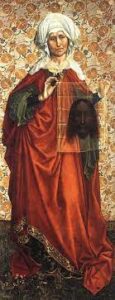Marjorie Kempe: accounts of madness, visitations and mysticism
The Book of Margery Kempe tells the story of one woman’s spiritual journey in Medieval England over a twenty-five-year period, and her quest to establish spiritual authority as a result of her personal conversations with Jesus and God. Whilst the text is written in the third person, it is generally acknowledged to be the first autobiography written in the English language. It is also recognised as being the first autobiographical account of madness.
The narrative begins around 1393, with the self-acknowledged onset of insanity, which pre-empts for Margery, then aged 20, a spiritual crisis. This illness is briefly described and the rest of her work describes conversations and visitations with Jesus, Mary, God and other religious figures. She also takes part in the birth and crucifixion of Christ. Her religious fervour was intense and famously led her to publicly express the ecstasies of her joy with loud wailing, sobbing and writhing, causing much irritation to clerics – some of whom saw her as a mystic – and to the commoners, who rather judged her as linked to the devil. Her book is then about her spirituality, but also about the divided reaction to her behaviour. She had 14 children, but went on extensive pilgrimages to Jerusalem, Rome, Germany and Spain in her 40s.
One writer about Marjorie Kempe has distinguished between her mental breakdown and her visions. Her breakdown looked at through contemporary eyes could have been a form of post-natal psychosis following the birth of her first child – she was physically ill and heard the voice of the devil and had demonic visions, resulting in isolation from her community by physical restraint. In the first chapter Marjorie Kempe describes how the visions and torment were continuous until one day when she woke alone in the room to find Jesus Christ sitting beside her. He asked, “Daughter, why have you forsaken me, and I never forsook you?” and then ascended slowly and vanished. Instantly her mind was clear and she regained her senses, asked to be released, and resumed her former life. The voice and vision of Jesus restored her reason, and it is through reason that Marjorie Kempe can determine what is a trustworthy vison and mystical experience as distinct from those that belonged to her illness. She makes it clear to the reader that true mystical experiences cannot take place without the exercise of reason. When Marjorie Kempe doubted herself and her visions, she went to visit the mystic anchoress Julian of Norwich who comforted and assured Marjorie Kempe that her visions and her weeping for the sins of the world came from God, not her own mind or the Devil, and that she should continue as she had been doing.
Her spiritual journey took her from wife and mother in Bishop’s Lynn to a chaste Christian visionary and popular – if controversial – public speaker. Marjorie Kempe was illiterate and dictated her life story first to one of her son’s and then to a priest. The final version of the book was completed in 1436 CE, and parts reprinted into the early 16th century. Then the book was lost until found in 1934 in a cupboard of the home of a Catholic family where it may have been hidden centuries before.
Marjorie Kempe
